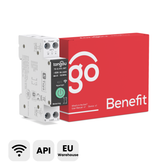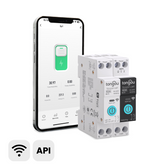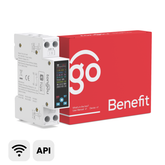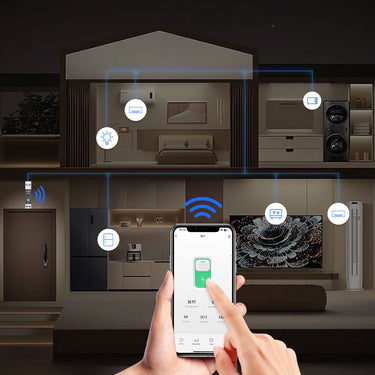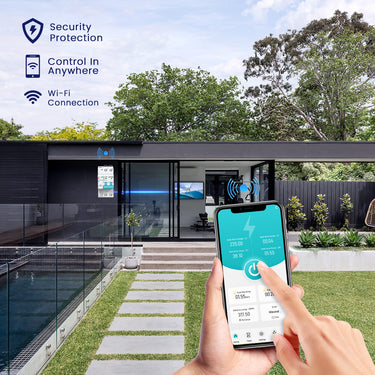What is Auto Reclosing? From Grid Stability to Smart Terminal Protection
Auto reclosing, a pivotal mechanism in modern electrical engineering, refers to the automatic closure of a circuit breaker after it has been opened due to a fault. This process is key to maintaining the continuity of the electrical supply and minimizing service interruptions. The device responsible for this task is known as an auto recloser. This article explores the evolution, principles, and crucially, the different applications of auto reclosers, from high-voltage grids to the smart protection in your building.
History before the invention of automatic reclosers
In the past, the lines were often touched, causing the circuit breaker tripping mechanism to occur, thus causing the line to lose power.
For example, if a bird touches the wire, the circuit breaker will trip and the power will be cut off. However, in general, the event of a bird touching the wire is temporary and will not last for a long time. However, the circuit breaker tripping requires manual re-operation, which requires a lot of labor and time, resulting in a lot of downtime and inefficiency.
Moreover, data shows that 90%-95% of the events that cause circuit power outages are temporary events, that is, instantaneous faults, which can often be restored by resetting the circuit breaker without other maintenance operations. Long-term power outages and numerous manual needs have made people start to think about whether there can be an automatically reset circuit breaker.
So the automatic reclosing circuit breaker was born.
Compared with traditional circuit breakers in the past, the automatic reclosing circuit breaker can quickly reset and restore power supply in a short time after power outage, but it should be noted that: this does not mean that the automatic reclosing circuit breaker only resets under certain circumstances.
Principles of Operation
Auto reclosers are designed to detect when an interruption occurs in the electrical network, typically caused by transient faults such as lightning strikes or temporary contact with foreign objects. Here’s how they work:
- Fault Detection: Once a fault is detected, the auto recloser temporarily opens its contacts, interrupting the current flow.
- Wait Period: The device then enters a wait period, allowing time for the fault to clear (such as when the offending object falls away or the surge dissipates).
- Reclosure: If the fault clears, the recloser automatically closes the contacts, restoring the circuit’s continuity. If the fault persists, this open-wait-close cycle repeats a predetermined number of times before locking out to prevent damage.
A Critical Distinction: Grid-Level vs. Terminal Auto Reclosers
It is essential to understand that "auto reclosing" is applied very differently in two distinct environments.
-
Grid-Level Reclosers (High/Medium Voltage): These are the large, utility-grade devices you see on power lines. Their primary job is to restore power after transient faults on long distribution lines (e.g., lightning strikes, tree branches briefly touching a line). The assumption is that the fault will clear itself. This is what the historical examples refer to.
-
Terminal Auto Reclosers (Low Voltage): This is where devices like the TONGOU TOSAR series operate. These are compact, intelligent devices installed in the final distribution board of a home, office, or facility. Their purpose is not to manage grid stability, but to provide intelligent, automated restoration for critical terminal circuits. The logic and applications are far more specific.
For the rest of this guide, we will focus on the modern applications and types of Terminal Auto Reclosers.
Types of Terminal Auto Reclosers
Auto reclosers are classified based on their operational phases and the number of poles they control:
In low-voltage applications, auto reclosers are typically classified by the type of protection they are paired with.
1. MCB Auto Reclosers: This configuration pairs an auto-reclosing unit with a standard Miniature Circuit Breaker (MCB). It is designed to automatically restore power after an overload or short-circuit trip.
2. RCD Auto Reclosers (RCBO/RCCB): This pairs the reclosing function with a Residual Current Device (RCD), providing automatic reset after a leakage current fault. These are available in different sensitivities:
- Type AC: For standard AC leakage currents.
- Type A: For AC and pulsating DC leakage, common with modern electronics.
- Type B: The highest level of protection, for AC, pulsating DC, and smooth DC leakage, essential for applications like EV chargers.
Modern Applications: Where TONGOU Auto Reclosers Shine
The TONGOU TOSAR series is not just a circuit breaker; it's a problem-solver for critical applications where manual resets are impractical, costly, or impossible.
Application 1: Unattended Communication and IT Infrastructure
-
The Problem: A remote communication tower, a rural ISP cabinet, or a server rack in a locked room experiences a temporary power glitch, causing a breaker to trip. The result is a critical service outage that requires an expensive and time-consuming site visit by a technician just to flip a switch.
-
The TOSAR Solution: A TOSAR+MP65 (MCB Recloser) installed on the circuit will attempt to restore power automatically. If the fault was transient, the service is back online in seconds, not hours. This dramatically increases uptime and slashes operational costs.
Application 2: Critical Pumping and Irrigation Systems
-
The Problem: A submersible pump for a farm's irrigation system or a building's sump pump trips due to a minor, temporary electrical disturbance. The crops don't get watered, or the basement risks flooding.
-
The TOSAR Solution: The recloser ensures the pump returns to service automatically, maintaining operational continuity for these vital systems without the need for constant human supervision.
Application 3: Advanced Protection for Sensitive Systems (with RCD Reclosers)
-
The Problem: An EV charging station or a solar PV inverter trips on a sensitive leakage fault (RCD trip). While this is a critical safety function, sometimes these can be nuisance trips caused by minor grid fluctuations.
-
The TOSAR Solution: A TOSAR+RD4B (Type B RCD Recloser) provides the necessary high-level protection. If a transient fault causes a trip, the recloser will attempt a reset, preventing a situation where a vehicle fails to charge overnight due to a minor, temporary event. The device is smart enough to lock out if the fault is permanent, ensuring safety is never compromised.
The Future of Uninterrupted Power
While the concept of auto reclosing began on the high-voltage grid, its modern evolution into compact, intelligent terminal devices like the TONGOU TOSAR series has unlocked new possibilities for automation and reliability.
By intelligently distinguishing between transient and permanent faults, TONGOU Auto Reclosers provide the ultimate solution for minimizing downtime, reducing maintenance costs, and ensuring the continuous operation of your most critical electrical circuits.
→ Explore the TONGOU TOSAR Auto Recloser Series and Upgrade Your System's Reliability


